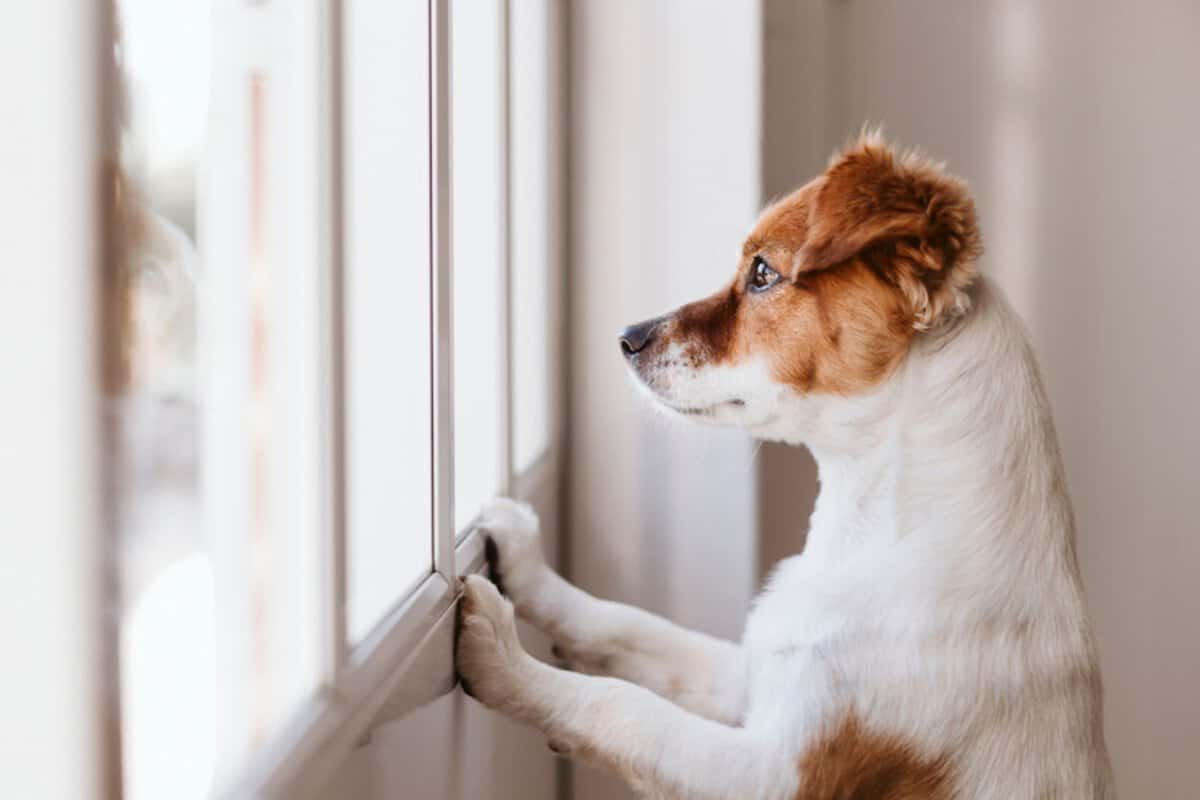Moving with a dog can be stressful for your dog. Our experience at Moving shows that many owners feel like they have to do everything at once. You might be registering your new address and packing boxes while your dog is running around in chaos. This can be stressful. We have tips to help you make the move as smooth as possible for your dog. In this guide, you will discover how to make your new home a safe place for your four-legged friend and how to keep things manageable during the move. Think of moving tips that will help you and your dog relax, even if the situation seems stressful.
Tips for moving
Moving with a dog or cat is not just about boxes and paperwork. It is also about your dog and how he experiences the change. Creatures of habit and sudden changes make dogs nervous quickly. That is why we recommend that you proceed step by step. Anxiety in a new home is something that your dog can suffer from and that is why it is important to prepare your cat or dog well.
It is important that you prepare the dog
You want to get your dog used to the new environment in advance. You can do this by letting him sniff around the new house before the actual moving day. Maybe you can go with the dog and explore the house together if possible. That way he won't feel overwhelmed when he first arrives in an empty house full of boxes. Also make sure that you don't leave your dog home alone for too long in the first few days around the move. Dogs feel safer when you are nearby and they don't end up in a canine carousel of unrest.
Moving with a dog or cat can be stressful
Try to maintain the same old habits. Keep your dog to his familiar walking routine and feed his kibble at the usual times. If your dog notices that the daily routine does not change too much, he will show less stress. If your dog really becomes anxious, you can consult a dog behaviorist. This will prevent behavioral problems from arising. All new things are scary for a pet, so give them time.
Make the move as normal as possible for your dog
Dogs recognize the smell of their toys, bed and blankets. Put these familiar items down when you arrive at your new home. Do not wash them just before you leave because the familiar smell reduces a dog's anxiety in a new place. Keep in mind that your dog will only really settle into his new home once he has his own corner. Place his bed in a quiet place, because he wants to be able to retreat when everything gets too busy. You can prevent this by taking the dog for an extra walk.
Moving with a dog doesn't have to be difficult
Also make sure your dog is chipped. Check that his registration is correct and don't forget to enter your new address in the database. After all, you don't want him to run away and not be found. Discuss with your new vet whether anything else is needed to acclimatize your four-legged friend. In some cases, a supplement or spray helps if your dog shows signs of stress. That depends on his character. Sometimes you can even take the dog with you or let him get used to it weeks before the move. Taking the dog in the car every now and then can be very good, for example. That way he is well prepared for the journey to the new home.
Use a checklist
A handy checklist will save you a lot of headaches. Note down in it:
- Chip check: is your dog in the database with the correct new address
- Moving day planning: decide whether your dog will come along or stay in a quiet place
- Collar check: Does your dog have a tag with your contact details?
- Old municipality: report your departure and register in your new municipality if necessary
- Your dog's belongings: keep them close at hand, not at the bottom of an overstuffed moving box
Thanks to such a checklist, you have all the important points at hand and you avoid panic at the last moment. It is a piece of cake if you think ahead and your dog gets as little as possible from the hustle and bustle.
Old habits are important when moving
Moving can be busy. Friends and family rush in and out, and things pile up in the hallway. You want the move to be as stress-free as possible for everyone.
Babysitter, boarding house or take the dog with you?
Ask yourself whether your dog should stay with you or whether he would rather stay safely with a familiar person. Does he have trouble with noise and strangers in the house? Then a familiar sitter is more relaxing for him. If your dog is coming along, check whether he feels comfortable. Give him enough attention and breaks during the ride. Make sure you never leave him alone in the car. This is not only dangerous but can also be stressful for your dog. Use a dog sitter if you see no other alternative. This keeps him out of the madness and protects his familiar environment. Letting a familiar person stay can often be a lot of fun for the dog and prevents possible behavioral problems.
Transport and safety. Never leave the dog alone
Windows and doors are often left open, so make sure your dog doesn’t wander around the new neighborhood off-leash. In a completely new environment, he can get lost and that will only cause stress. Put his favorite blanket and toys in the car when you leave. Give your dog time to get used to this setting. Also bring water to keep him hydrated during the drive and give him enough attention. When you arrive, you can take him straight to a quiet room. This will save him most of the chaos of lugging boxes.
After moving
Once in your new home, you want your dog to immediately feel that he is safe here. Those few days around the move sometimes decide how quickly he gets used to it. New smells such as a new house and/or new housemate just take some getting used to.
Getting used to the new environment
Only once inside the new home can your dog walk around a bit awkwardly. Let him sniff around and give him time to explore. Put his basket and toys in their place as soon as the furniture is in place. Also try not to rush the new home getting used to phase. Lead him around, show him where he can find food and water and where he sleeps. In this way he slowly builds up trust. Remember that it can be stressful for him if you immediately play loud music or start using drills. This can lead to behavioral problems.
New routines and repetition
You can try to maintain the same routine as much as possible. Old habits provide stability. Your dog will notice that you are just living on despite the move. For example, plan the same walking times as in your previous home. That helps him understand that only the house has changed and not his whole life. Always give the dog enough water to drink.
6 tips to make moving easier for your dog (or cat)
1. Getting used to it
If possible, let your dog visit the new home a few times. This will make moving less scary for your dog. Give him his favorite treat when he comes in so that he associates something positive with the new place.
2. Babysitter
Choose to place your dog with a friend or family member if you are worried that they will become upset. They will then remain in a familiar environment and will not be allowed into the new home until all the boxes have been unpacked. They can then choose to relax in the new home later.
3. Your pet's belongings
Take his basket, blankets and toys from your old house last. That way he has a familiar nest until the last moment. Put it in the new house and leave it off. That sounds simple but that smell gives immediate peace.
4. Stay indoors
Do not let the dog run off the leash in the new neighborhood for a while. He does not know the smells and sounds yet and can panic. Also take some time to observe his reactions before you let him sniff around freely.
5. Chipping
Make sure your dog is chipped and update the details. Don't forget to give your new address to the database because it can happen that he runs away in his dog or cat enthusiasm and doesn't find the way back himself. Try to make enough time for the dog so that everyone has a good feeling.
6. Stay at home
Consider whether your dog would like to be with you on moving day. Some dogs benefit from this. You do want to prevent him from getting in the way when you are carrying boxes. In that case, you can keep him in a separate room where he feels safe.
How can you prevent stress in dogs?
You can prevent stress in dogs by building in enough rest points during the move. Create moments when you sit on the floor together and pet him. Then he feels supported. Give him a fixed schedule. Dogs are creatures of habit who quickly become restless when everything suddenly changes.
Also take the time to let your dog get used to all new experiences calmly and clearly. For example, just place a favorite pillow in the car. Small details like that can reduce a dog's anxiety in a strange car. This way, the dog's environment remains less scary.
How can you treat stress in dogs?
Is your dog still stressed? Then you can give your dog extra support:
- Behavioral scientist: A professional quickly recognizes the core of his unrest and gives targeted advice.
- Supplements or spray: Some remedies help a dog relax faster. This works especially with mild to moderate tension.
- Play and interaction: A dog that stays physically and mentally busy has less time to worry. Keep games short but challenging.
- Quiet introduction: Take him for short walks around the new neighborhood and keep it positive. Reward good behavior with a treat or a cheerful voice.
Moving can be stressful for your dog
Moving can be stressful, but fortunately there is a lot you can do to make it as stress-free as possible. We know that during the journey and after unpacking, uncertainty can still arise, but most dogs get used to it with enough love and attention. It is important that you do not let him get lost in a big mess of new impressions. Provide overview and safety.
Stay as calm as possible yourself
We hope these tips will help you move with a dog or cat. Stay calm and try to put these tips for moving into practice. Your dog will sense how you behave. If you radiate calm, your dog will experience that too. Together, you will encounter as little stress as possible through this move. We have given tips, but above all, follow your own intuition because every dog is unique.
Moving is happy to help you
Greetings from the Moving team! If you have any additional questions, please let us know via our social media links or send us a message. We are always here to help you.

